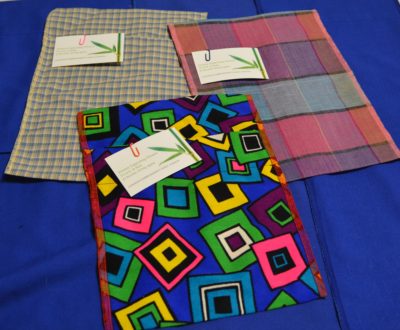
In the friendly and quaint village of London, Ontario’s Old South, tucked away in the basement of the majestic Wesley-Knox United Church, there’s a sweat shop.
No guff.
Each assigned a specific task, 15 to 25 women sit in clusters at tables toiling all day long – well organized, perfectly choreographed and intensely focused. They cut, fold, serge, sew and snip, taking few breaks and churning out hundreds of brightly coloured garments designed and destined for a very specific – and special – customer.
If not for the laughter and love, compassion and camaraderie in the room, there might be cause for concern. But it is the spirit of generosity that brings these women together, and their giving heart is stitched into every piece they create.
They are known as the “Bag Ladies” because they make fabric bags to hold the surgical drains and tubes required by breast cancer patients after surgery. The drains are inserted during surgery and remain for three to five days, sometimes as long as two weeks, post –operatively.
The fabric bags, which can be worn on a belt, neatly contain the drainage containers and tubes making them easier and more comfortable for the patient to manage.
The Bag Ladies are all members of the Canadian Embroiderers’ Guild, London, and the “sweatshop” is a cherished annual gathering that yields a vital supply of the bags for the Breast Care Program of St. Joseph’s Health Care London. Every year, the Bag Ladies donate nearly 400 of the hand-crafted bags to the hospital.
“The sisterhood of the Bag Ladies is amazing,” says Sue Hickey, long-time guild member and current organizer of the Bag Ladies outreach project. “It’s so rewarding. We feel we are making someone’s life easier and adding a woman’s touch, a dose of humanity and a splash of colour to the clinical and sterile hospital experience and recovery.”
Breast Care Program staff and physicians see daily the difference the bags make for patients.
“The kind generosity of the Canadian Embroiderers’ Guild offer a personal touch to our patients at a time when they may feel vulnerable and anxious,” says nurse practitioner Pat Baruth. “We are so appreciative of their contribution to our patient’s journey, which can be stressful at times.”
Breast surgery can be very emotional, adds surgical oncologist Dr. Muriel Brackstone, Medical Director of St. Joseph’s Breast Care Program. “And having drains that hang out, get caught and constantly tug and hurt are an ongoing reminder that they are not the same as they once were. The bags are so convenient that patients rave about them to me, but I can see that it is more than the physical convenience of drain storage. It’s tangible evidence that other women who they have never met, care about them and wish them well in their recovery.”

The Bag Ladies’ beginning dates back about two decades, when a guild member was diagnosed with breast cancer and underwent surgery.
“She kept getting the tubes caught on door knobs, drawer handers and like projections,” says Sue. “She knew there had to be a better way – one that would be more comfortable and more aesthetically able to accommodate the paraphernalia. The first bag was conceived to suit the needs of this guild member, which received an enthusiastic response from the nurses and surgeon when they saw it.”
Members of the guild set about mass producing the bags, which have been modified over years as the drainage containers have changed. Relying on donations of unused fabric, the goal is to produce about 500 bags a year. While the majority of the bags are created during the annual, fun-filled yet industrious sweatshop-style “Bag Ladies Day,” some guild members work on them at home all year long.
Sue, who became a bag lady in 2013 and took over as lead bag lady in 2015, has some impressive credentials for the job. A fibre artist by training, she was a fashion designer in England and Ireland – even worked in the costume department of an opera company – and taught design at Fanshawe College before switching gears to become a law clerk, retiring in 2002. She runs a tight, sweatshop ship with Bag Ladies Day carefully orchestrated to produce as many bags as possible.
“The women come prepared to work hard but also to laugh and cheer our success,” says Sue, whose passion is also personal. Her mom was a breast cancer survivor who underwent a radical mastectomy nearly 40 years ago. The bag project, she says, “is one of the most rewarding things I have ever done.”
At St. Joseph’s Hospital, every breast surgery patient with drains receives a bag lady bag, and each bag comes with a card clipped to the pocket with the group’s mission stated in a simple sentence:
“Women supporting women, to rest, to heal, to become strong again.”
Dahlia Reich works in Communication and Public Affairs at St. Joseph’s Health Care London.

